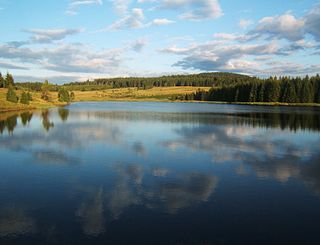
The Ore Mountains lie along the Czech–German border, separating the historical regions of Bohemia in the Czech Republic and Saxony in Germany. The highest peaks are the Klínovec in the Czech Republic at 1,244 metres (4,081 ft) above sea level and the Fichtelberg in Germany at 1,215 metres (3,986 ft).

Puchberg am Schneeberg is a town in the south-eastern part of Lower Austria with approximately 2650 inhabitants. It is situated about 80 Kilometres from Vienna. The highest point of Puchberg is the Schneeberg with 2076 m, the highest mountain of Lower Austria.

Aue is a small town in Germany at the outlet of the river Schwarzwasser into the river Zwickauer Mulde in the Ore Mountains, and has roughly 16,000 inhabitants. It was merged into the new town Aue-Bad Schlema in January 2019. Aue was the administrative seat of the former district of Aue-Schwarzenberg in Saxony, and is part of the Erzgebirgskreis since August 2008. It belongs to the Silberberg Town League

Schneeberg is a town in Saxony’s district of Erzgebirgskreis. It has roughly 16,400 inhabitants and belongs to the Town League of Silberberg. It lies 4 km west of Aue, and 17 kilometres (11 mi) southeast of Zwickau.

The 140-kilometre-long road, the Silver Road is the first and longest holiday route in the German Free State of Saxony. Against the background of the importance of mining in the history of Saxony, the road links those sights and tourist attractions of the Ore Mountains and its foreland that relate to the centuries-old mining and smelting industries of the region.
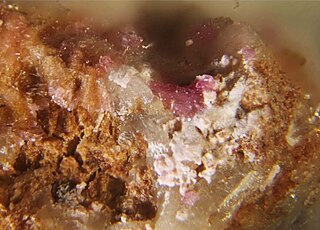
Weilite (CaHAsO4) is a rare arsenate mineral. It is a translucent white triclinic mineral with a waxy luster.

August Ferdinand Anacker was a German composer.
Enrico Kern is a German football coach and former player. He worked as manager for FC Erzgebirge Aue U19.
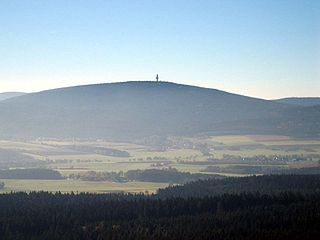
Schneeberg is the highest mountain in the Fichtel Mountains, a mountain range in Upper Franconia in northeast Bavaria, Germany. It can be readily identified from a distance by its squat tower - a relic of the Cold War. The summit comprises a jumble of granite rocks and a rock pillar (Felsburg) on which the Backöfele observation tower stands and is still dominated by the relics of military installations including its Cold War listening post.

Werte der deutschen Heimat originally Werte der Deutschen Heimat and, between 1970 and 1990 called Werte unserer Heimat, was a series of publications by former East German Academy of Sciences at Berlin, that was published by Akademie-Verlag Berlin and included more than 50 volumes. The work was undertaken by the Academy’s Local History Working Group within the Institute for Geography and Geo-ecology.

Rauenstein Castle is a castle in the village of Rauenstein in the town of Pockau-Lengefeld in the Ore Mountains of Central Europe. The castle guarded the crossing over the River Flöha along the road from Freiberg to Annaberg.
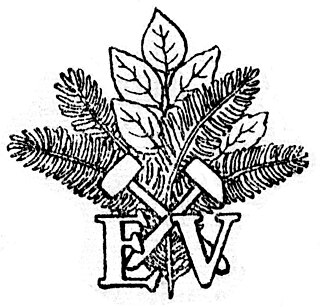
The Ore Mountain Club is one of the oldest and most tradition-steeped local history, mountain and hiking clubs in Germany. The club was founded in 1878. After the Second World War the club and its many branches were banned by the East German authorities, but it was refounded in West Germany in Frankfurt am Main in 1955. Only after the political events of Die Wende in 1990 was it newly founded in the Ore Mountains. At the end of 2008 the club had over 3,859 members in 61 branches. Before 1945 there were more than 25,000 members. In 1929 the Ore Mountain Club even had over 28,000 members in 156 branches and managed several accommodation houses on the Fichtelberg near Oberwiesenthal and the Schwartenberg between Seiffen and Neuhausen/Erzgeb.
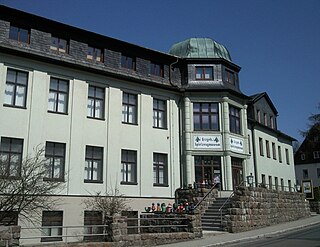
Ore Mountain folk art is a well-known form of highly artistic wood carving from East Germany. It encompasses the diverse forms of expression of the creative work beyond the classical or the modern arts, and in particular the production of figures, sculptures and paintings. In a broader sense, the people's poetry, literature, and the Ore Mountain songs are in itself the folk art. The Ore Mountains claim to be the largest, enclosed folk art area in Germany.
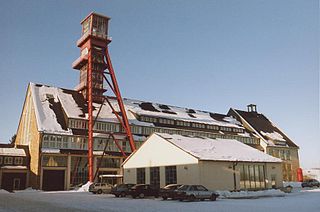
The Ore Mountain Mining Region is an industrial heritage landscape, over 800 years old, in the border region of the Ore Mountains between the German state of Saxony and North Bohemia in the Czech Republic. It is characterised by a plethora of historic, largely original, monuments to technology, as well as numerous individual monuments and collections related to the historic mining industry of the region. On 6 July 2019, the Erzgebirge/Krušnohoří Mining Region was inscribed as a UNESCO World Heritage Site, because of its exceptional testimony to the advancement of mining technology over the past 800 years.
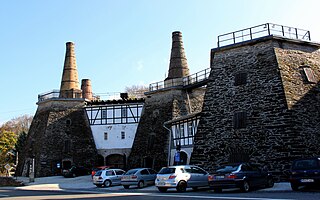
The Lengefeld Lime Works was a limestone mine southwest of Lengefeld in the Saxon town of Pockau-Lengefeld in the Ore Mountains. In 2016, the mine was closed.

Christian Gottlob Steinmüller was an organ builder in Germany.

Rosina Schnorr, was a German business person.
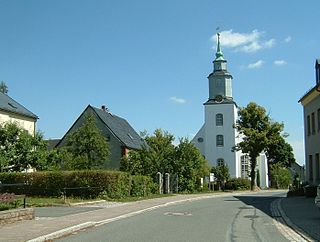
Hundshübel is a village in Erzgebirgskreis district of Saxony, forming a subdivision of the municipality of Stützengrün in the Ore Mountains. It is located north of Eibenstock Dam on federal highway B 169.
The 2019–20 FC Erzgebirge Aue season was the 74th season in the football club's history. They competed in the 2. Bundesliga, the second tier of German football, in which they finished 7th, and the DFB-Pokal, where they were eliminated in the second round. They played their home matches at the Erzgebirgsstadion, located in Aue, Saxony, Germany.
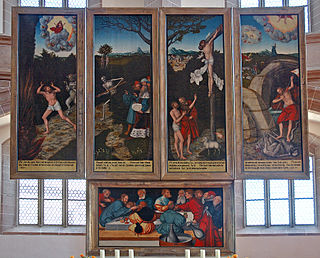
The Schneeberg Altarpiece is a Lutheran winged altarpiece created in 1539 by Lucas Cranach the Elder for the Church of St. Wolfgang in Schneeberg in Saxony, Germany. The altarpiece was commissioned in 1531–1532 by the Elector of Saxony John I of Saxony and installed in the church in 1539, making it the first Protestant altarpiece of Reformation which is considered a Saxon masterpiece of art.



















